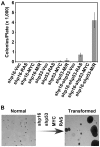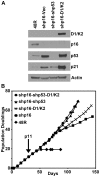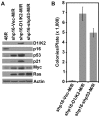Constitutive CCND1/CDK2 activity substitutes for p53 loss, or MYC or oncogenic RAS expression in the transformation of human mammary epithelial cells
- PMID: 23390492
- PMCID: PMC3563539
- DOI: 10.1371/journal.pone.0053776
Constitutive CCND1/CDK2 activity substitutes for p53 loss, or MYC or oncogenic RAS expression in the transformation of human mammary epithelial cells
Abstract
Cancer develops following the accumulation of genetic and epigenetic alterations that inactivate tumor suppressor genes and activate proto-oncogenes. Dysregulated cyclin-dependent kinase (CDK) activity has oncogenic potential in breast cancer due to its ability to inactivate key tumor suppressor networks and drive aberrant proliferation. Accumulation or over-expression of cyclin D1 (CCND1) occurs in a majority of breast cancers and over-expression of CCND1 leads to accumulation of activated CCND1/CDK2 complexes in breast cancer cells. We describe here the role of constitutively active CCND1/CDK2 complexes in human mammary epithelial cell (HMEC) transformation. A genetically-defined, stepwise HMEC transformation model was generated by inhibiting p16 and p53 with shRNA, and expressing exogenous MYC and mutant RAS. By replacing components of this model, we demonstrate that constitutive CCND1/CDK2 activity effectively confers anchorage independent growth by inhibiting p53 or replacing MYC or oncogenic RAS expression. These findings are consistent with several clinical observations of luminal breast cancer sub-types that show elevated CCND1 typically occurs in specimens that retain wild-type p53, do not amplify MYC, and contain no RAS mutations. Taken together, these data suggest that targeted inhibition of constitutive CCND1/CDK2 activity may enhance the effectiveness of current treatments for luminal breast cancer.
Conflict of interest statement
Figures







References
-
- Hanahan D, Weinberg RA (2011) Hallmarks of cancer: the next generation. Cell 144: 646–674. - PubMed
-
- Land H, Parada LF, Weinberg RA (1983) Tumorigenic conversion of primary embryo fibroblasts requires at least two cooperating oncogenes. Nature 304: 596–602. - PubMed
-
- Parada LF, Land H, Weinberg RA, Wolf D, Rotter V (1984) Cooperation between gene encoding p53 tumour antigen and ras in cellular transformation. Nature 312: 649–651. - PubMed
-
- Ruley HE (1983) Adenovirus early region 1A enables viral and cellular transforming genes to transform primary cells in culture. Nature 304: 602–606. - PubMed
-
- Rangarajan A, Hong SJ, Gifford A, Weinberg RA (2004) Species- and cell type-specific requirements for cellular transformation. Cancer Cell 6: 171–183. - PubMed
Publication types
MeSH terms
Substances
Grants and funding
LinkOut - more resources
Full Text Sources
Other Literature Sources
Research Materials
Miscellaneous

